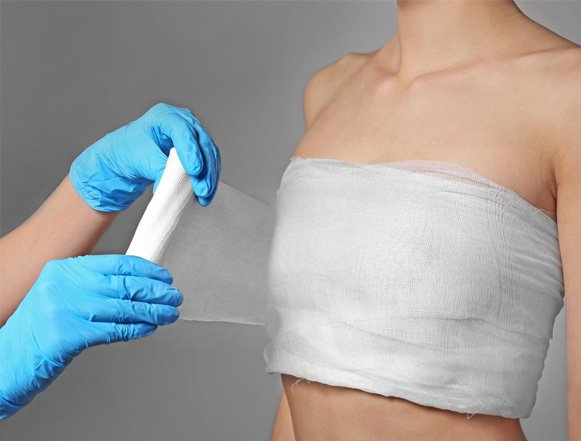Breast cancer, or carcinoma of the breast (CA breast), is the most commonly occurring cancer in women. As per the World Health Organisation (WHO), 6.7 lakh women in the world lost their lives in 2022 due to breast cancer. WHO further states that 1 out of 12 women in nations with high Human Development Index (HDI) is likely to develop breast cancer, while in countries with low HDI, 1 out of every 27 women has the chance of being diagnosed with breast cancer.
The good news is that advancements in surgical treatments and early detection of breast cancer help improve outcomes of CA Breast surgery. Keep reading this guide as it explores the entire process from diagnosis to recovery and deciding on different breast cancer surgery options. We will also talk about what to expect during recovery.
For the result-oriented CA breast surgery and post-operative care in India, book your consultation with expert oncologists at Cancer Therapy India, Bangalore.
Step 1: Diagnosis and Evaluation
Diagnosis of the cancer is the first step. This involves tests like
- Breast ultrasound or sonograms that capture the area inside the breast.
- Screening mammograms help detect abnormalities or lumps in the breast.
- Diagnostic mammograms are advised by the doctor in case abnormalities or lumps are detected.
- MRI or Breast magnetic resonance imaging gives detailed pictures of the inside of the breast.
- Biopsy, like Fine needle aspiration (FNA), Core needle biopsy, or Surgical biopsy, is advised to confirm cancer type and grade.
Staging
Before CA breast surgery or deciding on the treatment options, it is important that the stage of the cancer is evaluated. This is called staging, where it is determined if the cancer has spread inside the breast only or to other body parts. Determining the stage helps the doctor decide the right course of treatment.
Step 2: Choosing the Right Surgical Option

Surgery remains a cornerstone of breast cancer treatment. The type of CA breast surgery depends on the size, location, and stage of the tumor, as well as patient preference and genetic factors. If you need guidance on breast cancer surgery options, you can speak with expert oncologists at Cancer Therapy India, Bangalore.
The common breast cancer surgery options are –
Lumpectomy or Breast-Sparing Surgery
In this case, the ductal carcinoma in situ or the tumor only is removed by the surgeon. In some cases, some normal tissues surrounding the tumor or lymph nodes under the arm may also be removed.
This surgical process is followed by radiation therapy, hormone or targeted therapy, and chemotherapy.
Mastectomy
In this breast cancer surgery option, the whole breast containing cancerous cells is removed by the surgeon. There are two types of mastectomy.
- Total mastectomy or simple mastectomy – The entire breast is removed along with one or a few lymph nodes from the underarm through a procedure called sentinel lymph node biopsy.
- Modified radical mastectomy – In this surgical procedure, the entire breast is removed and a majority of lymph nodes from the underarm. Patients who have undergone mastectomy may also require chemotherapy, radiation theray, targeted or hormone therapy. Many patients wear prosthesis or go in for breast recconstruction surgery.
Mastectomy followed by breast reconstruction surgery
This CA Breast surgery procedure features mastectomy along with breast reconstruction surgery. A plastic surgeon carries out the reconstruction surgery. A tissue or an implant from the patient’s body is used to create a breast-like shape to replace the normal breast that was surgically removed.
The reconstruction surgery can be performed later, too.
Step 3: Preparing for Surgery

Tests like blood tests for assessing your overall health, swab tests to check for infections, and how fit you are medically for anaesthesia are performed. An ECG, lung function tests, echocardiogram, and cardio-pulmonary exercise test are performed.
Besides, you’ll have to sign your consent on certain forms. Your surgeon will inform you of the details of the procedure, risks, outcomes, and the need for additional treatments like chemotherapy or radiation.
You need to arrive at the hospital on the day of the operation.
Step 4: The Day of Surgery
Most breast surgeries are done under general anesthesia. You will be required to stay overnight after the CA Breast surgery.
- Patients undergoing lumpectomy usually go back home the same day. Make sure that you are not alone and have relatives or friends accompanying you.
- Your doctor will advise you on what to eat and what not to eat before the surgery. Generally, patients are advised not to eat or drink anything from the previous night.
- Certain medications will not be allowed for consumption before the surgery. Speak with your doctor for more information.
Step 5: Recovery After Surgery

- After surgery, patients are moved to a recovery room for monitoring until the anesthesia wears off.
- When you wake up after the surgery and till the aftereffects of anaesthesia wear off, you are closely monitored.
- There will be nasal tubes fitted for oxygen.
- Your pulse and blood pressure will be measured continuously.
- At this point, you might feel a bit dizzy and lazy.
- A drip could be running for blood transfusions and fluids.
- There will be a catheter connected for urine collection.
- There will be a few tubes near the wound for stopping fluid buildup.
- There will be a dressing on the wound, and you will typically go back home with this.
- The stitches on the wound are mostly dissolvable and need not be taken out.
Wounds may take about 2 to 3 weeks to completely heal. Your doctor will advise you on showering and bathing, eating, and drinking requirements.
Pain is normal for a few weeks. You will be given medications for pain management. You might be advised to undergo physiotherapy for shoulder and arm exercises for recovery after surgery.
The first week or two will be characterised by pain, swelling, and bruising at the site. By the third week, you should be able to return gradually to daily activities. By the end of the first month and in the next two months, you should be able to resume most normal activities.
Long-Term Care and Surveillance
After CA Breast surgery, you will need to regularly monitor for recurrence. Your follow-ups with the doctor will continue. Initially, it would be monthly and then annually. Tests will be recommended for monitoring the site and other tissues nearby.
You will be required to make lifestyle modifications. Your doctor will advise you on the same, and you must follow it sincerely.
Choosing the right breast cancer surgery option is primarily a medical decision. Your surgeon and the team will help you understand the risks, benefits, and cosmetic outcomes of each procedure.
If you are searching for a hospital in Bangalore for holistic treatment, from diagnosis to recovery, Cancer Therapy India is the best. The hospital offers cutting-edge treatments with expert oncologists and a dedicated support team. Schedule a consultation today.

